Mighty Oaks from Acorns
From whalebone corsets and horse harnesses, and from steamer trunks and ballet slippers, some of today’s most renowned names in fashion and accessories started as small artisan shops. Here is an inside look at how they bloomed into the household names we know today.
CADOLLE – REPETTO – HERMÈS – CHANEL – LOUIS VUITTON

The 1st Arrondissement corner of Rue St-Honoré and Place Vendome has become, in recent years, a hub of high fashion, competing with the Faubourg St-Honoré, the Champs Elysees, and Avenue Montaigne for preeminence in designer names. Its claim to that title evolved over the past decade as the neighboring Rue Faubourg St-Honoré (Gucci, Prada, Hermès, etc.), saw skyrocketing real estate costs that drove smaller boutiques down the Rue St-Honoré in the direction of Place Vendome.
The Place Vendome itself has long been an oasis of high-end jewelers and watch companies (Cartier, Bulgari, Rolex, Patek-Phillipe, etc.). The 2017 opening of Lous Vuitton’s marvelous flagship store at the intersection of these two streets signaled that the neighborhood had arrived. Since then, Dior, Chanel, Gucci, and a score of other iconic trademarks have migrated to elegant shops nearby.
But long before this quarter attained its chic status, its surrounding streets were the home of artisanal craftsmen and struggling would-be designers. Countless failed but a few survived and thrived. As you make your shopping pilgrimage through the area it may be of interest to know their stories.
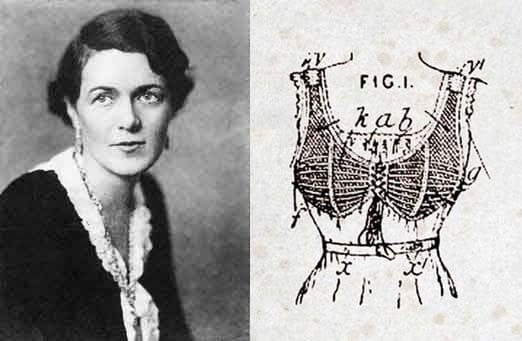
CADOLLE – The birth of the BRA
The wardrobe of fashionable ladies in the 19th Century’s Belle Époque era relied on a stiff and constraining undergarment, the corset. in 1884 Herminie Cadolle opened a boutique near the Paris Opera, specializing in lingerie and corsetry. Her emphasis on quality made her corsets quite popular. Yet, by its very nature the corset was still an uncomfortable (And unhealthy) contraption. It was Herminie who first separated the top from the bottom of the corset for flexibility and comfort, and in the process invented the first “BRA”. She filed for a patent on it in 1889 and showcased it at the famous Universal Exposition of 1900. Though the bra was slowly gaining acceptance, the corset still remained in vogue until the first World War, when women started working in factories replacing men who had gone off to war. The need for flexibility and comfort brought Herminie’s invention to the forefront where it has remained.
Herminie became the fitter of bras to queens, dancers, and actresses. The Femme Fatale and alleged WWI spy, Mata Hari, was known to be a customer of Cadolle.
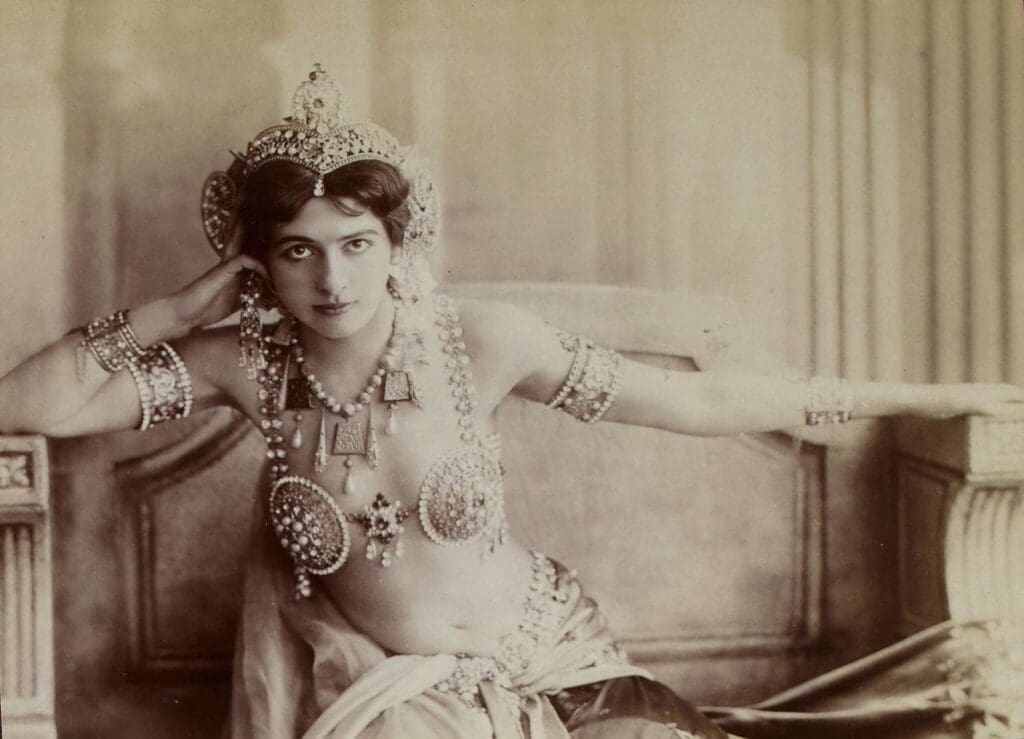
The post WWI era saw another boost to the house of Cadolle through a collaboration with Coco Chanel who in the 1920’s developed a women’s style of more relaxed contour, freeing women from the rigid corset-oriented styles of pre-WWI (More about the House of Chanel a little later).
As the 20th Century progressed, Cadolle continued to innovate with lacier fabrics and was the first to use elasticized material (Rubber thread woven into the fabric).
In 1910 Cadolle relocated to its present shop on Rue Cambon, a half block South of Rue St-Honoré. While strolling the neighborhood, stop into this small historic boutique to see beautiful bras, undergarments, and elegant lingerie. Perhaps you’ll rub elbows with royalty, a movie star, or a spy.

REPETTO – From ballet stage to fashion rage.
The story of Repetto dates back almost 80 years to the 1940’s when an accomplished dancer and seamstress, Rose Repetto, was asked by her son, Roland Petit, himself a famous dancer and choreographer, to design a more comfortable pair of ballet shoes for him.
Drawing on her expertise in sewing and dance, she crafted a revolutionary design, a soft, flexible, and supportive ballet shoe using a unique stitching technique, known as “stitch-and-return.” This technique involves stitching the sole inside out and then turning it right side out, providing dancers with superior comfort and flexibility.
This new design became a hit with her son and fellow dancers at the Paris Opera. In 1947 Rose officially founded her brand, Repetto, and started producing ballet shoes for professional dancers and ballet schools.
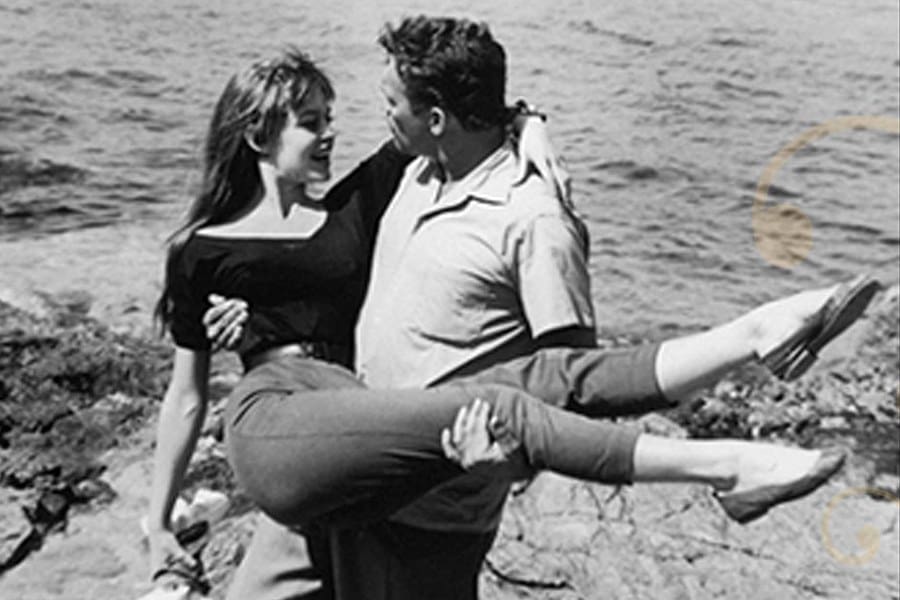
Almost a decade later the brand’s reputation soared when the legendary French actress and dancer, Brigitte Bardot, approached Rose and requested an everyday flat with the look and feel of a ballet shoe. The result was called the Cendrillon (Cinderella), which Bardot wore in the 1956 film Et Dieu Créa la Femme (And God Created Woman), starting a footwear revolution. Bardot’s association with the brand catapulted Repetto’s ballet flats into the world of fashion, making them popular not only among dancers but also among stylish women around the globe. Its popularity among other mid-century starlets like Anouk Aimée and Audrey Hepburn also added to its appeal. It’s fashion status eventually became a cultural and artistic symbol. In 2018 the iconic Cendrillon Ballerina shoe was inducted into New York’s Museum of Modern Art’s permanent collection.
At the Repetto shop, located a block North of Place Vendome, you can see the latest variations in Rose’s original design as well as a line of fashionable attire. And in keeping with the company’s roots, a ballet Tutu is on display in the window.
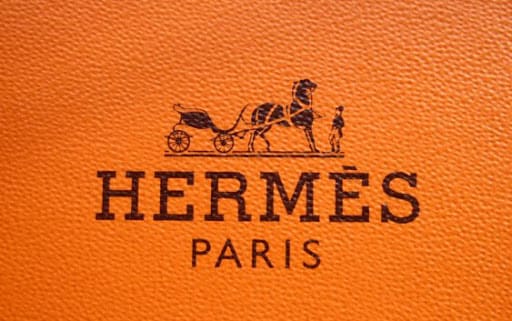
HERMÈS– From bridles and saddles to purses and scarves.
This iconic brand of leather goods and fashion accessories began in 1837 when Thierry Hermès, a skilled harness-maker and saddler, opened a small shop providing equestrian bridles and saddles to the aristocrats of Paris. Pierre’s focus on quality and craftsmanship made him the popular choice of the city’s upper class.
The turning point for Hermès came in the late 19th century when Thierry’s son, Charles-Émile Hermès, took over the business. Under his guidance, Hermès expanded its offerings to include a wide range of leather goods, such as bags, luggage, and accessories, while still maintaining its principal lines of equestrian gear. The brand’s attention to detail, use of premium materials, and dedication to craftsmanship became synonymous with luxury.
In the 20th century, Hermès continued to solidify its status as a prestigious fashion house with the creation of some of its most iconic pieces. In 1935, Hermès introduced the “Sac à Dépêches,” later known as the “Kelly bag,” named after actress Grace Kelly. The bag gained popularity in the 1950’s after Kelly famously used it to shield her baby bump from the paparazzi during her pregnancy.
Another creation, the “Sac à Courroies,” was developed in 1935 but came to prominence in 1984 when it morphed into the iconic Birkin Bag. The Birkin Bag was a response from Hermès CEO Jean-Louis Dumas to actress and singer Jane Birkin, who expressed a desire for a larger handbag. The bag’s practicality and elegant design, along with its connection to Birkin, made it a must-have fashion accessory.
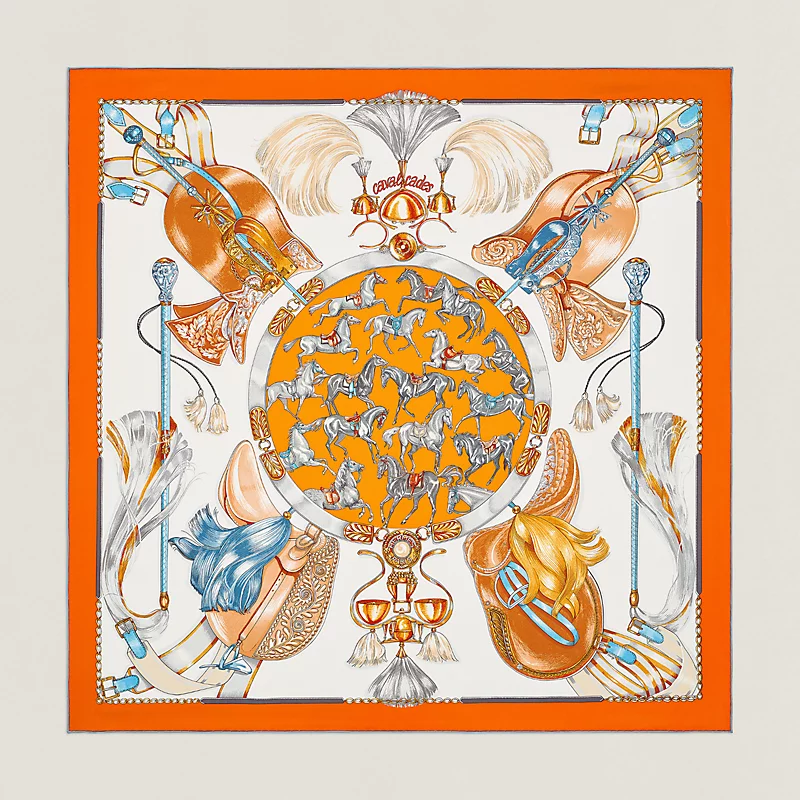
The latter 20th Century also saw expansion into silk scarves, perfumes, and clothing lines.
The frequently seen equestrian motifs (Horses, saddles, stirrups, and harnesses) on many of Hermès’ famous scarves are a nod to the company’s origin as saddle and harness makers.
Hermès remains a family business. Now in its sixth generation of family ownership, it is almost unique among the great fashion houses of Europe, many of whom have merged or been acquired by giant conglomerates like the Louis Vuitton empire.*
The store has thus far resisted the trend to move east along Rue St-Honoré toward Place Vendome, still occupying its longtime position a few blocks West along ultra chic Rue Faubourg St Honoré.
*Louis Vuitton’s parent company, LVMH, made attempts at a Hermès takeover a decade ago, gradually buying up circa 23% of Hermès stock, but has since relinquished most of its shares.
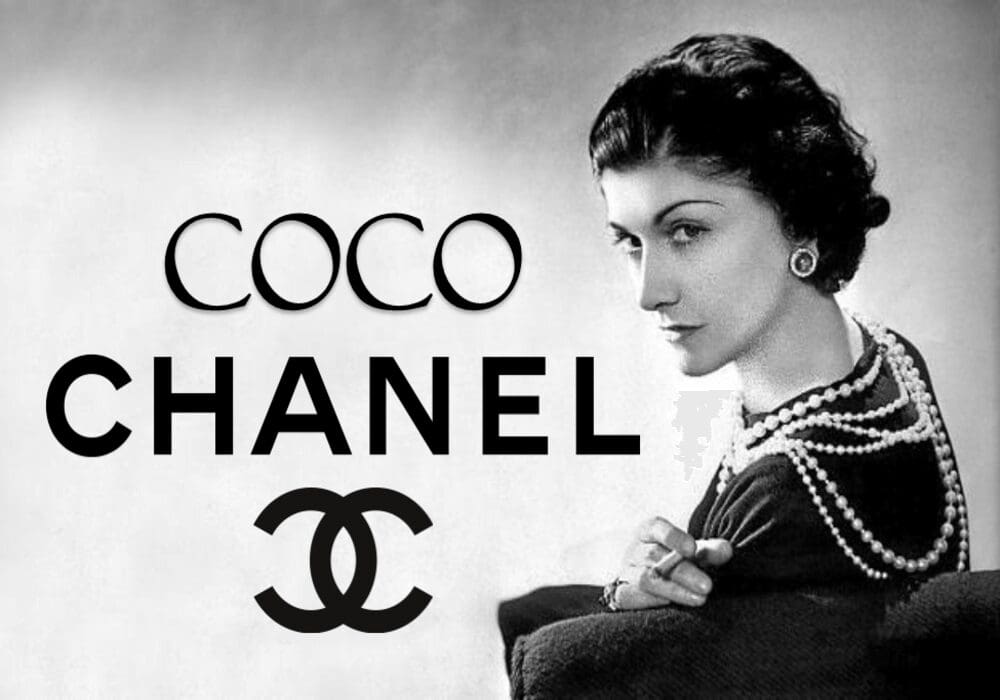
CHANEL – From the Orphanage to the Ritz
In 1910, the same year that Herminie Cadolle moved her shop to Rue Cambon, a few blocks to the North at No. 21, Gabrielle “Coco” Chanel opened a hat shop. From this tiny millinery boutique there would evolve one of the great fashion houses of the 20th Century. In 1921 the shop was moved down the street to bigger quarters at No 31 where it remains today. This address became the epicenter of the Chanel empire and home to one of the most charismatic, enigmatic, and influential personalities in the history of fashion. *
Coco Chanel’s life story reads like a novel. From grim childhood poverty in an orphanage, to the heights of the Paris fashion scene, her creativity, perseverance, and drive revolutionized the world of women’s fashion with simple relaxed lines and comfortable fabrics that were a dramatic departure from the stiff corseted attire of pre-WWI.
Her rise was meteoric, due in part to her creations and astute business acumen, but also through a dazzling string of social connections and love affairs with British aristocrats, Russian composers, and (It is rumored) a German diplomat during WWII.
She counted Winston Churchill, Igor Stravinsky, Salvador Dalí, and Jean Cocteau as friends and carried on a 10 year affair with the Duke of Westminster, the wealthiest aristocrat in England.
In the 1920’s, along with her expansion into clothing and jewelry, Coco developed what was to become her most successful venture, perfume. Her Chanel No.5 fragrance was a sensation and remains extremely popular today. Her royalties from the fragrance line made her wealthy and bankrolled many of her other enterprises. When the Rue Cambon store closed for several years during the Nazi occupation of WWII, Coco’s worldwide perfume royalties still allowed her to maintain her luxurious lifestyle, which included a permanent suite across the street at the Ritz Hotel. It was in that suite, on January 10, 1971, that Coco died in her sleep at the age of eighty-seven, having ruled the fashion world for more than six decades.
Her legacy is profound, and remnants of her genius still remain in the “Little Black Dress”, the padded chain-handled Chanel bag, Chanel No.5, and in the interlocking “C” logo which she designed. Her empire is now controlled by Alain and Gerard Wertheimer, grandsons of Pierre Wertheimer who financed Chanel’s entry into the perfume business back in the 1920’s. Their fortune is estimated to be in excess of $80 Billion.
While there are other Chanel outlets around Paris, including a glamorous multistory shop on Rue St-Honoré, faithful acolytes of Chanel still make their pilgrimage to that original shop at 31 Rue Cambon.
- She is the only fashion designer listed on Time Magazine’s list of the one hundred most influential people of the 20th century
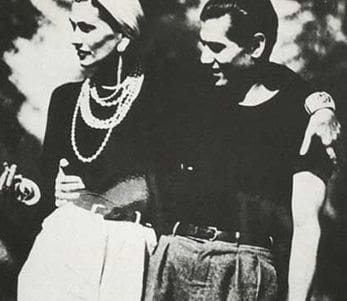
The Love of Her Life – Arthur “Boy” Capel was a self-made British millionaire, author and intellectual. He and Coco carried on a nine year romance beginning in 1910. He provided the financial backing and stylistic inspiration which launched Coco’s career. His tragic death in an automobile accident on the way to rendezvous with Coco devastated her. She went into a lengthy period of mourning, wearing black for several years. Her extensive use of black turned it from a color of mourning to one of elegance, and the chic black gowns created during this time eventually evolved into the timeless “Little Black Dress” which remains a fashion staple to this day.
Some have theorized that her famous interlocking double “C” logo does not stand for Coco Chanel, but for Chanel and Capel – a touching tribute, if true.
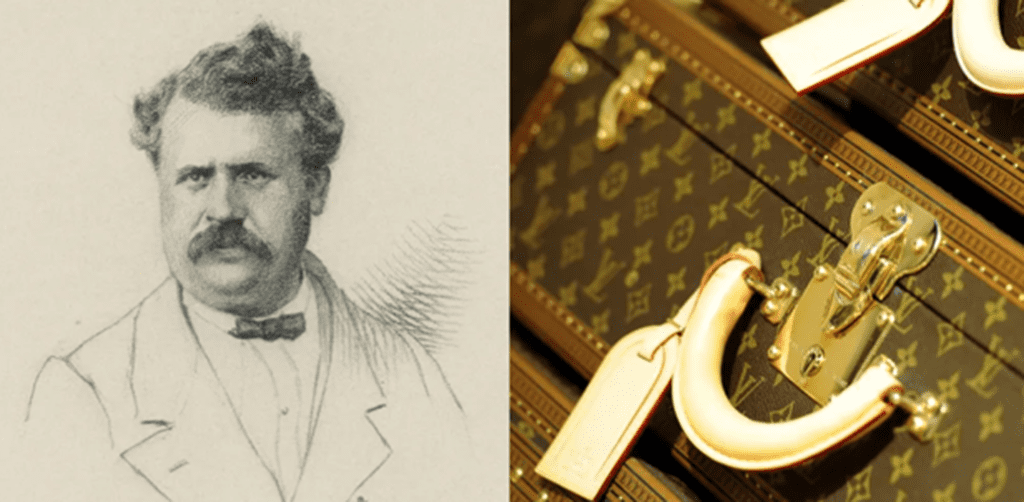
LOUIS VUITTON – From steamer trunks to fashion stardom
Great fortunes sometimes evolve from unlikely sources. Just as Hermès evolved from a saddle-maker, the Louis Vuitton empire was born in the workshop of a manufacturer of steamer trunks.
Louis Vuitton opened his Paris shop in 1854. His success came from his redesigning of the traditional steamer trunk of the day. Up till then, trunks were heavy wooden boxes with curved tops for rain and salt water to run off,
Louis Vuitton revolutionized their design with lightweight yet strong waterproof materials and flat tops which allowed for stacking. His revolutionary design caught on with wealthy aristocrats, including Empress Eugenie, wife for Napoleon III. Eugenie’s patronage added prestige and luxury status to the Vuitton enterprise.
Its success was such that many counterfeiters attempted to copy their product.
In an effort to thwart counterfeiting, a checkered “Damier” pattern was printed on the LV canvas trunks; (A pattern that has been resurrected in recent decades on a line of LV bags). Counterfeiting attempts continued so in the 1890’s Louis’ son, George, developed the now iconic LV logo to distinguish their product. Additional anti-counterfeit measures eventually led to the well-known brown & tan background being printed on all the Vuitton trunks and bags. Its colors and intricacy made it harder to copy. The LV logo is now recognized as the number one luxury label in the world.
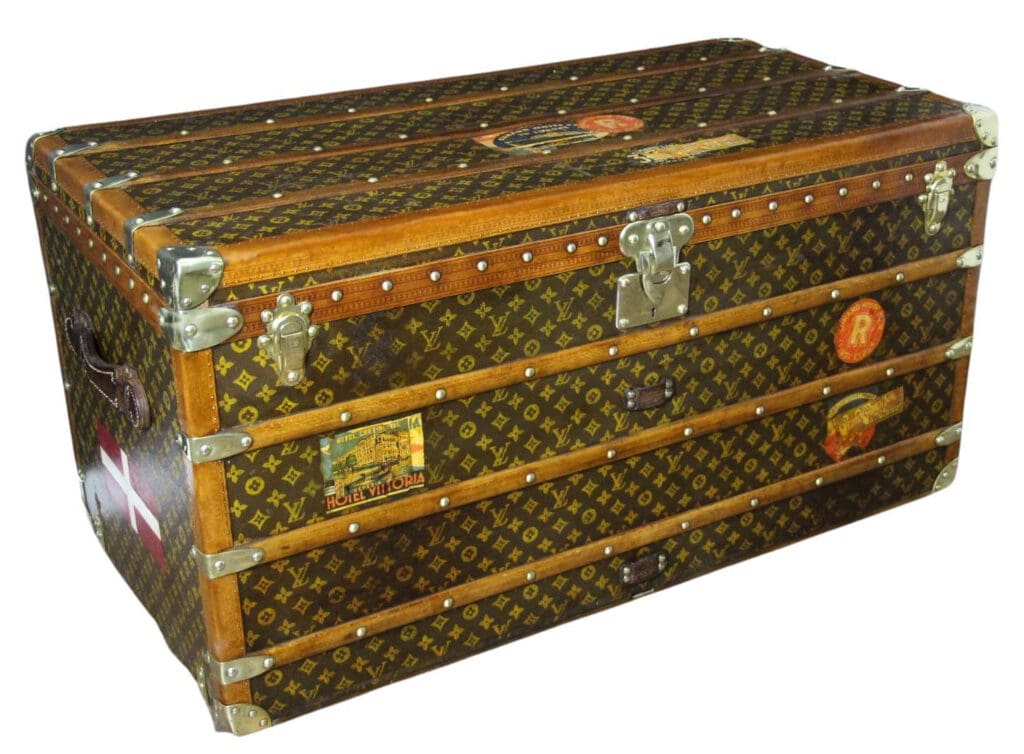
Despite the setbacks of two World Wars, the 20th Century saw the brand continue to grow and diversify into clothing lines, jewelry, and sunglasses, and from wholesale marketing to luxury retail outlets. LV’s big surge came in 1987 when it merged with the Moet Hennessey company, producers of high end champagne and cognac. The resulting company became LVMH.
In a boardroom power struggle, Bernard Arnault became CEO of LVMH in 1989 and has since built a fashion empire and personal fortune of nearly $200 Billion, putting him in a head-to-head race with Elon Musk for Richest Man in the World.
Luxury shoppers may be surprised to know that the LVMH holding company controls not only Louis Vuitton, but over 60 other luxury brands including Tiffany & Co., Christian Dior, Fendi, Givenchy, Marc Jacobs, Stella McCartney, Loewe, Loro Piana, Kenzo, Celine, TAG Heuer, Bulgari, Guerlain, Sephora, DKNY, La Samaritaine, Bon Marché, Dom Perignon, Veuve Clicquot, and Princess Yachts.
Who could have imagined that the dream of Louis Vuitton, a penniless 19th-centiury youth who walked four hundred kilometers from his village to Paris in search of a dream, would become the fashion empire it is today? With a capitalization of nearly $500 Billion, it is the most valuable company in France.
Yes, mighty oaks from little acorns grow.
For an interesting video about the ingenious Louis Vuitton luggage line, click on this link:
ADDRESSES
CADOLLE: 4 Rue Cambon, 75001
REPETTO: 22 Rue de la Paix, 75002
HERMES: 24 Rue du Faubourg Saint-Honoré, 75008
CHANEL: 31 Rue Cambon, 75001
LOUIS VUITTON 2 Pl. Vendôme, 75001


Good https://is.gd/tpjNyL
Good https://is.gd/tpjNyL
Awesome https://shorturl.at/2breu
Awesome https://shorturl.at/2breu
Very good https://lc.cx/xjXBQT